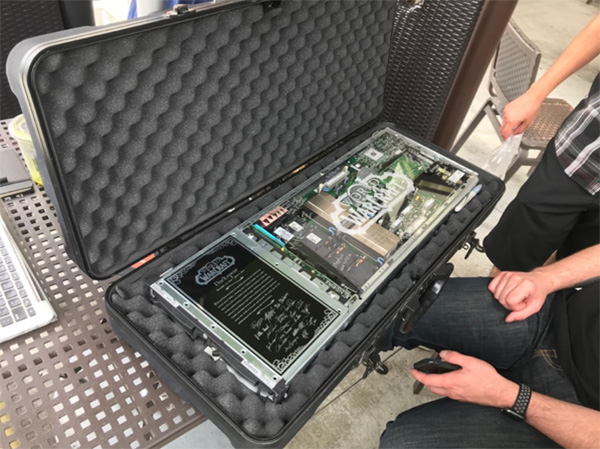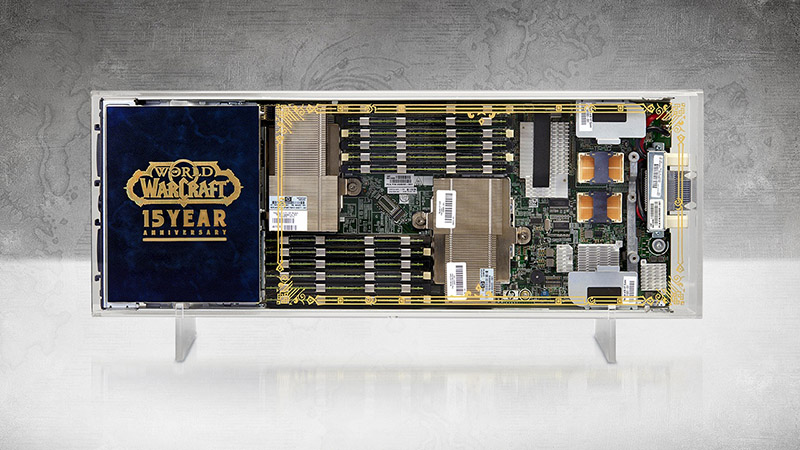“It’s amazing to think those little circuits that we can carry around were an entire world to us.” –Diana*, interviewee
“We might say that this capacity of objects to serve as traces of authentic experience is, in fact, exemplified by the souvenir.” –Susan Stewart, On Longing: Narratives of the miniature, the gigantic, the souvenir, the collection (1984)
In 2011, just seven years after the birth of World of Warcraft (WoW), the game’s development company decided to implement some major changes to their server architecture. Rather than disposing of the decommissioned server hardware that had helped run the game world since the beginning, they auctioned it off for charity. For long-time players of WoW, these pieces of server hardware hold value because they are pieces of the virtual game world that hold spatial memory. WoW players have historically viewed servers as persistent and discrete places, places where players played together, formed relationships, and faced challenges. In this short post, I will outline how owners of commemorative WoW server hardware treat these objects as mementos of their time in the world of WoW.**
Is the server blade a souvenir?
WoW works as a social space by connecting its player base through a collection of hundreds of servers. Every server is a discrete copy of WoW, categorized by different parameters for play and time zone; and each hosts its own community, with unique reputations, norms, and histories. In this way, players have come to view WoW servers as places (called “realms”), akin to neighborhoods. When the game developer Blizzard Entertainment decommissioned some of their server blades to be auctioned off, they turned them into commemorative commodities, adding an etching onto the metal frame with the server’s name (e.g., “Proudmoore” or “Darkspear”), its dates of operation, and an inscription: “within the circuits and hard drive, a world of magic, adventure, and friendship thrived… this server was home to thousands of immersive experiences.” While stripped of their ability to store virtual memory or connect people to an online game world, these servers were valuable and meaningful as worlds and homes. They became repositories of social and spatial memory, souvenirs from WoW.
And people jumped at the opportunity to own a relic of WoW history and a physical piece of the thing that once housed their experiences in this virtual world. In interviews, players had some difficulty describing exactly why they found the blades meaningful. They would often refer to them as mementos or “a piece of WoW” that they could take with them to display in their home. For example, one player, William, explained that the server blade auctions were comparable to the demolition of Hubba Hideout in the Embarcadero in San Francisco. With its multiple slopes and staircases, Hubba Hideout had been a popular spot for skateboarding fanatics. When it was destroyed, frequent visitors to the spot lined up to receive pieces of bricks, material traces of a place that no longer existed.

A group of WoW players reminisce around a server blade, image by author
Like the skateboarders’ brick, the server blade has the function of a souvenir; it is a memento of a place in time, a catalyst for remembering. In her book On Longing (1984), Susan Stewart writes, “The souvenir may be seen as emblematic of the nostalgia that all narrative reveals—the longing for its place of origin” (1984, xii). The server blade has acquired value for the player because it is an object of nostalgia, nostalgia for an older WoW lost to time. Players cite their memories of playing with others on their server as important reasons why the server blade is such a precious item to own. Just as the skateboarder’s brick might remind the nostalgic skateboarder of a particular time skating with friends, the server blade might remind the nostalgic gamer of a particular time raiding with guildmates. They are both physical remnants of a place that indexes a different time.
However, the server blade is quite dissimilar to the skateboarder’s brick insofar as it is not just a piece of a place. Because servers are the objects that “host” players, the server blade operates as both place and souvenir. In a very real sense, it is ontologically the place it represents. And it acquires its value as a souvenir through both its placeness and its capacity to index a network of memories, relationships, and experiences the nostalgic player yearns for.
“Everything’s different now”
And its materiality matters! As one player, Darien, explained to me: “when you live in the digital world, everything is ephemeral. You don’t keep anything physical and everything goes away and nothing is kept forever… It was cool to hold that and say okay, there are memories that I have, that this piece of machine gave me.” The server blade is prized as a physical, tactile object from the world of WoW not only because the player gets to touch and hold it (and according to one player’s account, even to lick it), but also because it is a rare moment when the virtual world literally materializes.
Through player narratives about these server blades, we can better understand the complex affective connections players form within game worlds, while also giving us new ways to think of scale in material-virtual relations (e.g., that an entire virtual world is encapsulated in this object). And physically, these worlds have gotten even smaller.

The new server blades, image by Blizzard Entertainment
The way these servers structure the network of World(s) of Warcraft has changed dramatically over time. It used to be that, when you connected to the game, your computer communicated with a particular server that others were also connecting to, and that server was formed by four servers connected together. These days, many servers can be simultaneously on one physical blade. The servers being networked together in this new way has had all sorts of impacts on gameplay and social relations (for more on that, see Nikki Crenshaw’s 2017 dissertation), which has also affected the way players relate to the game servers themselves. One player, Wilson, explained, “That made me less, I guess less loyal to the server I was on because at that point it didn’t really matter.” The server blades from 2011 were objects of nostalgia for a time when servers actually mattered as discrete places in the multiverse of WoW. William insisted he wouldn’t be bidding on newer server blades in the future: “I don’t know if I would do it again. Cause I just don’t care about my server.”
So, it should come as no surprise that this year, when Blizzard put up new server blades for sale on their website—a flat cost of $300 USD rather than an auction—many (but not all) players expressed severe disappointment. These new server blades no longer had the inscribed plaques with the name and date of the server (also called a “realm”) it once hosted. The blades are shells, really heavy decorative slabs of metal, with a different set of meanings for players. The Blizzard website highlights this: “Due to advancements in the technology behind World of Warcraft and the ability to host many realms on one blade, there’s no way to guarantee purchasers will receive a server blade that previously hosted a specific realm they were interested in.” Because the relationship between blade and server can no longer be conflated, it is difficult for the player to relate to the server blade as a place they used to inhabit. Without the dates of operation and the name of the server etched onto the surface, the new server blades are alienated from both place and time. Lacking temporal and spatial specificity, they will not, as souvenirs from specific places do, “capture its viewer into reverie” (Stewart 1984). As virtual worlds become more virtual and physical servers look like relics, what happens to these worlds and the relations of the players within them? What happens to players’ senses of place?
*All interviewee names are pseudonyms.
**This research was funded through a Doctoral Dissertation Research Improvement Grant from the National Science Foundation.
References
Crenshaw, Nikki K. “Social Experience in World of Warcraft: Technological and Ideological Mediations.” PhD diss., University of California, Irvine, 2017.
Stewart, Susan. 1984. On longing: Narratives of the miniature, the gigantic, the souvenir, the collection: Duke University Press.

2 Trackbacks